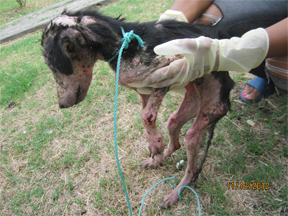Dear Editor,
On Nov 12, 2012, friend and animal activist, Judy Beepat, called me around 1pm. She told me of a puppy in distress in her village in Lusignan. It was a hot afternoon and not wanting to make a long drive I asked her to call a vet. Judy called me back and told me to look at the picture she had just sent to my Facebook page. I went online, saw the horrifying picture and immediately called her saying I was on my way.

I reached Judy’s home and in her calm and beautiful way she led me down the street to a small wooden house where the puppy “lived.” Editor, I have rescued many animals that live in hell because of human ignorance and abuse, but the condition of this puppy were among the worst I’ve ever seen. She was hunched into a ball in her makeshift stinky pen, one of her paws was broken, she had almost no hair; even her skin seemed to be falling off. She was the saddest puppy you could imagine. Judy picked her up and put her into my dog kennel and I took her to the animal shelter. The puppy never once cried, but I can’t say the same for Judy and me.
Before we left that yard, we saw another sad site – a parrot living in a cramped little cage that was dirty and stinky. His water bottle and feeding bowl were so filthy you couldn’t see the plastic. The parrot had been in that small cage for 8 years (nearly all its life) balancing on a small piece of wood and eating whatever was provided. Editor, after leaving that home of doomed animals I could not stop thinking about that parrot. A few days later, I could not take it any more so I returned with my fellow animal rights activist (Soraya) to speak to the owner. He was not home but his wife gave us permission to enter the yard. The parrot cage was still filthy so we asked the lady to take it down and with the help of Judy the cage was given a thorough washing and replaced the water bottle and food pan. We now intend to raise money to get the parrot a larger cage or perhaps even buy the parrot’s freedom.
Editor, this kind of home and yard in Lusignan is so common in Guyana they must number in the tens of thousands. In general the houses may be rundown and in need of repairs and the yards are small and unkempt and often flooded. Often the males are under-employed and the women work part-time in unskilled jobs earning minimum wages. Living on just a survival income, families still want to keep pets for company and security. But just like children, pets need housing, food and water, health services and a lot of love. Since many people with pets cannot afford to keep them the animals suffer, get sick and die or are abandoned and the owners look for new baby pets to adopt. It seems like it is easier and cheaper for poor people to adopt a new pet rather than to heal a sick one. Given this situation it would take a small army of volunteers to resolve the plight of animals in Guyana. Perhaps what is needed is an intensive education programme that reaches into the various communities in coastal Guyana and educates animal owners as to appropriate ways of caring for and keeping animals healthy at minimum cost to the owners.
“Unseen they suffer, unheard they cry, in agony they linger, in loneliness they die.“
Anonymous
Yours faithfully,
Syeada Manbodh





